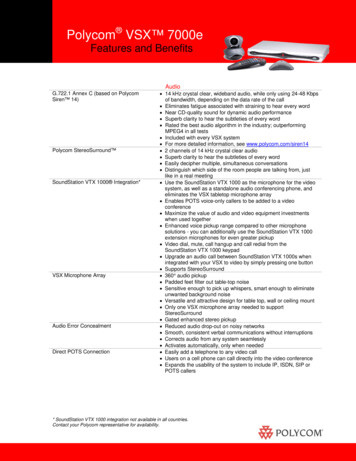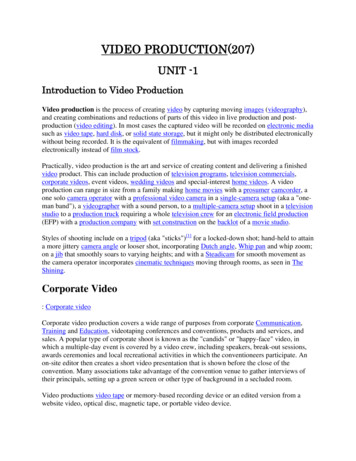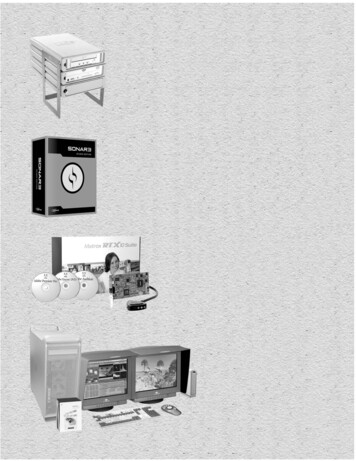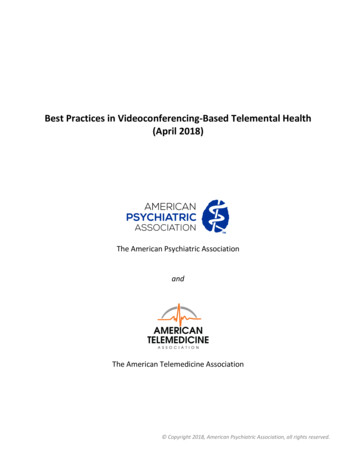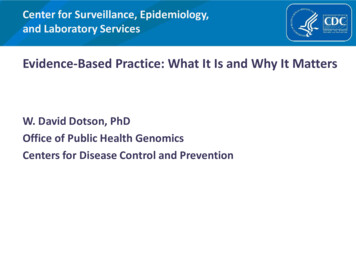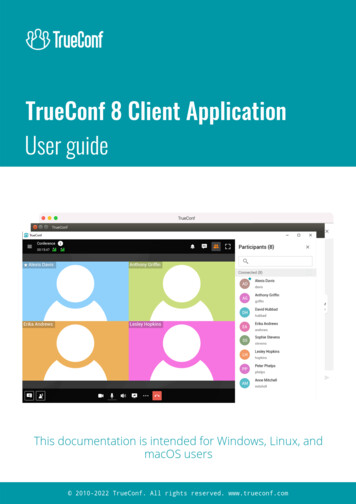
Transcription
National Professional Development Center onAutism Spectrum DisordersModule: Video ModelingEvidence-Based Practice Brief: Video ModelingThis evidence-based practice brief on video modeling includes the followingcomponents:1.2.3.4.Overview, which gives a quick summary of salient features of thepractice, including what it is, who it can be used with, what skills it hasbeen used with, settings for instruction, and additional literaturedocumenting its use in practiceSteps for Implementation, detailing how to implement the practice in apractitioner-friendly, step-by-step processImplementation Checklist, to be used to monitor fidelity of the use of thepracticeEvidence Base Summary, which details the NPDC-ASD criteria forinclusion as an evidence-based practice and the specific studies thatmeet the criteria for this practiceVideo Modeling: Cover SheetNational Professional Development Center on ASD10/2010Page 1 of 1
National Professional Development Center onAutism Spectrum DisordersModule: Video ModelingOverview of Video ModelingFranzone, E., & Collet-Klingenberg, L. (2008). Overview of video modeling. Madison, WI: TheNational Professional Development Center on Autism Spectrum Disorders, WaismanCenter, University of Wisconsin.Video modeling is a mode of teaching that uses video recording and display equipment toprovide a visual model of the targeted behavior or skill. Types of video modeling include basicvideo modeling, video self-modeling, point-of-view video modeling, and video prompting. Basicvideo modeling involves recording someone besides the learner engaging in the target behavioror skill (i.e., models). The video is then viewed by the learner at a later time. Video self-modelingis used to record the learner displaying the target skill or behavior and is reviewed later. Pointof-view video modeling is when the target behavior or skill is recorded from the perspective ofthe learner. Video prompting involves breaking the behavior skill into steps and recording eachstep with incorporated pauses during which the learner may attempt the step before viewingsubsequent steps. Video prompting may be done with either the learner or someone else actingas a model.EvidenceVideo modeling meets evidence-based practice (EBP) criteria with eight single-subject studies.With what ages is video modeling effective?The evidence-based research suggests that video modeling can be effectively implemented withlearners from early childhood through middle school. This practice may prove useful with highschool age learners as well, though no studies were identified to support its use at this agelevel.What skills or intervention goals can be addressed by video modeling?In the evidence-based studies, the domains of communication, social, academic/cognition, andplay were represented. It may be useful in the behavior domain as well; however, no studieswere identified to support the use of video modeling in this domain.In what settings can video modeling be effectively used?In the studies that serve as the foundation for the evidence base, video modeling wasimplemented in home and school settings. This practice, however, may be useful anywherethere is learner access to viewing equipment.Video Modeling: OverviewNational Professional Development Center on ASD10/2010Page 1 of 3
National Professional Development Center onAutism Spectrum DisordersModule: Video ModelingEvidence BaseThe studies cited in this section provide the basis upon which this practice was determined tomeet the NPDC of ASD’s criteria as an evidence-based practice. This list is not exhaustive;other quality studies may exist but were not included.PreschoolApple, A. L., Billingsley, F., & Schwartz, I. S. (2005). Effects of video modeling alone and withself-management on compliment-giving behaviors of children with high-functioningASD. Journal of Positive Behavior Interventions, 7(1), 33-46.D’Ateno, P., Mangialpanello, K., & Taylor, B. A. (2003). Using video modeling to teach complexplay sequences to a preschooler with autism. Journal of Positive Behavior Interventions,5(1), 5-11.Gena, A., Couloura, S., & Kymissis, E. (2005). Modifying the affective behavior of preschoolerswith autism using in-vivo or video modeling and reinforcement contingencies. Journal ofAutism and Developmental Disorders, 5, 545-56.Kroeger, K. A., Schultz, J. R., & Newsom, C. (2007). A comparison of two group-delivered socialskills programs for young children with autism. Journal of Autism and DevelopmentalDisorders, 37(5), 808-817.Sherer, M., Pierce, K. L., Paredes, S., Kisacky, K. L., Ingersoll, B., & Schreibman, L. (2001).Enhancing conversation skills in children with autism via video technology. Which isbetter, “self” or “other” as a model? Behavior Modification, 25(1), 140-158.Elementary and Middle SchoolCharlop, M. H., & Milstein, J. P. (1989). Teaching autistic children conversational speech usingvideo modeling. Journal of Applied Behavior Analysis, 22(3), 275-285.Nikopoulos, C. K., & Keenan, M. (2004). Effects of video modeling on social initiations bychildren with autism. Journal of Applied Behavior Analysis, 37(1), 93-96.Sherer, M., Pierce, K. L., Paredes, S., Kisacky, K. L., Ingersoll, B., & Schreibman, L. (2001).Enhancing conversation skills in children with autism via video technology. Which isbetter, “self” or “other” as a model? Behavior Modification, 25(1), 140-158.Taylor, B. A., Levin, L., & Jasper, S. (1999). Increasing play-related statements in children withautism toward their siblings: Effects of video modeling. Journal of Developmental andPhysical Disabilities, 11(3), 253-264.Video Modeling: OverviewNational Professional Development Center on ASD10/2010Page 2 of 3
National Professional Development Center onAutism Spectrum DisordersModule: Video ModelingSelected Additional ReferencesBellini, S., Akullian, J., & Hopf, A. (2007). Increasing social engagement in young children withautism spectrum disorders using video self modeling. School Psychology Review, 36(1),80-90.Coyle, C., & Cole, P. (2004). A videotaped self-modeling and self-monitoring treatment programto decrease off-task behavior in children with autism. Journal of Intellectual andDevelopmental Disability, 29, 3-16.Sigafoos, J., O’Reilly, M., & de la Cruz, B. (2007). How to use video modeling and videoprompting. Austin, TX: Pro-Ed.Video Modeling: OverviewNational Professional Development Center on ASD10/2010Page 3 of 3
National Professional Development Center onAutism Spectrum DisordersModule: Video ModelingEvidence Base for Video ModelingThe National Professional Development Center on ASD has adopted the following definition ofevidence-based practices.To be considered an evidence-based practice for individuals with ASD, efficacy must beestablished through peer-reviewed research in scientific journals using:randomized or quasi-experimental design studies. Two high quality experimental orquasi-experimental group design studies,single-subject design studies. Three different investigators or research groups musthave conducted five high quality single subject design studies, orcombination of evidence. One high quality randomized or quasi-experimental groupdesign study and three high quality single subject design studies conducted by atleast three different investigators or research groups (across the group and singlesubject design studies).High quality randomized or quasi experimental design studies do not have critical design flawsthat create confounds to the studies, and design features allow readers/consumers to rule outcompeting hypotheses for study findings. High quality in single subject design studies isreflected by a) the absence of critical design flaws that create confounds and b) thedemonstration of experimental control at least three times in each study.This definition and criteria are based on the following sources:Horner, R., Carr, E., Halle, J., McGee, G., Odom, S., & Wolery, M. (2005). The use of singlesubject research to identify evidence-based practice in special education. ExceptionalChildren, 71, 165-180.Nathan, P., & Gorman, J. M. (2002). A guide to treatments that work. NY: OxfordUniversity Press.Odom, S. L., Brantlinger, E., Gersten, R., Horner, R. D., Thompson, B., & Harris, K. (2004).Quality indicators for research in special education and guidelines for evidence-basedpractices: Executive summary. Arlington, VA: Council for Exceptional Children Divisionfor Research.Rogers, S. J., & Vismara, L. A. (2008). Evidence based comprehensive treatments for earlyautism. Journal of Clinical Child and Adolescent Psychology, 37(1), 8-38.Video Modeling: Evidence BaseNational Professional Development Center on ASD10/2010Page 1 of 2
National Professional Development Center onAutism Spectrum DisordersModule: Video ModelingUsing these criteria, the empirical studies referenced below provide documentation forsupporting video modeling as an evidence-based practice. This list is not exhaustive; otherquality studies may exist that were not included.PreschoolApple, A. L., Billingsley, F., & Schwartz, I. S. (2005). Effects of video modeling alone and withself-management on compliment-giving behaviors of children with high-functioningASD. Journal of Positive Behavior Interventions, 7(1), 33-46.D’Ateno, P., Mangialpanello, K., & Taylor, B. A. (2003). Using video modeling to teach complexplay sequences to a preschooler with autism. Journal of Positive Behavior Interventions,5(1), 5-11.Gena, A., Couloura, S., & Kymissis, E. (2005). Modifying the affective behavior of preschoolerswith autism using in-vivo or video modeling and reinforcement contingencies. Journal ofAutism and Developmental Disorders, 5, 545-56.Kroeger, K. A., Schultz, J. R., & Newsom, C. (2007). A comparison of two group-delivered socialskills programs for young children with autism. Journal of Autism and DevelopmentalDisorders, 37(5), 808-817.Sherer, M., Pierce, K. L., Paredes, S., Kisacky, K. L., Ingersoll, B., & Schreibman, L. (2001).Enhancing conversation skills in children with autism via video technology. Which isbetter, “self” or “other” as a model? Behavior Modification, 25(1), 140-158.Elementary and Middle SchoolCharlop, M. H., & Milstein, J. P. (1989). Teaching autistic children conversational speech usingvideo modeling. Journal of Applied Behavior Analysis, 22(3), 275-285.Nikopoulos, C. K., & Keenan, M. (2004). Effects of video modeling on social initiations bychildren with autism. Journal of Applied Behavior Analysis, 37(1), 93-96.Sherer, M., Pierce, K. L., Paredes, S., Kisacky, K. L., Ingersoll, B., & Schreibman, L. (2001).Enhancing conversation skills in children with autism via video technology. Which isbetter, “self” or “other” as a model? Behavior Modification, 25(1), 140-158.Taylor, B. A., Levin, L., & Jasper, S. (1999). Increasing play-related statements in children withautism toward their siblings: Effects of video modeling. Journal of Developmental andPhysical Disabilities, 11(3), 253-264.Video Modeling: Evidence BaseNational Professional Development Center on ASD10/2010Page 2 of 2
National Professional Development Center onAutism Spectrum DisordersModule: Video ModelingSteps for Implementation: Video ModelingThese steps for implementation were adapted from:LaCava, P. (2008). Video modeling: An online training module. (Kansas City: University ofKansas, Special Education Department). In Ohio Center for Autism and Low Incidence(OCALI), Autism Internet Modules, www.autisminternetmodules.org. Columbus, OH:OCALI.The implementation process for video modeling is similar for each type of video modelingstrategy (i.e., basic video modeling, video self-modeling, point-of-view modeling, videoprompting). Ten steps are outlined below which describe how video modeling is implementedwith learners with ASD.Step 1. Targeting a Behavior for TeachingIn Step 1, teachers/practitioners focus on identifying a behavior for the learner with ASD toacquire and then clearly describe it so that accurate data can be collected throughout theintervention process to monitor its effectiveness (Sigafoos et al., 2007).1. Teachers/practitioners identify a target behavior that is important for the learner to betaught.Target behaviors may include communication skills (e.g., requesting, giving compliments,initiating interactions with peers).2. Teachers/practitioners define and describe the target behavior so that is observable andmeasurable.Example of a non-observable behavior: “Mary will increase her social skills with peers.”Example of an observable and measurable behavior: “Mary will initiate interactions with peersby saying, „Hi,‟ at lunch and small group work time each day without prompting from adults.”Step 2. Having the Correct EquipmentTeachers and other practitioners must have access to two basic pieces of equipment toimplement video modeling techniques with learners with ASD: (a) something to make the videoand (b) something to show the video (Sigafoos et al., 2007).1. Teachers/practitioners acquire a video recording device (e.g., hand-held camera,computer technology).Videos can be created by using any number of devices including (a) traditional video cameras,(b) hand-held or micro video cameras, or (c) digital cameras. Picking the right device will bebased on resources that are available in schools and districts and budget constraints.Video Modeling: Steps for ImplementationNational Professional Development Center on ASD10/2010Page 1 of 6
National Professional Development Center onAutism Spectrum DisordersModule: Video Modeling2. Teachers/practitioners identify how the video will be played back (e.g., DVD, VCR,computer).Two basic devices are used to show videos: (a) a TV with a video cassette player (VCP) orDigital Video Disk (DVD) or (b) a computer with a video player (e.g., Real Player, Apple QuickTime Player, Windows Media Player).3. Teachers/practitioners are familiar with the equipment and are comfortable using it.Teachers and other practitioners should practice using all equipment before implementing videomodeling interventions with learners with ASD. This will ensure that the intervention isimplemented as smoothly as possible.Step 3. Planning for the Video RecordingIn Step 3, teachers and other practitioners plan for the video recording by creating scripts thatcan be used during the taping process.1. Teachers/practitioners write a script or task analysis detailing exactly what needs to besaid and/or done on the video.Creating a script or task analysis of the skill that is being taught is very important for videomodeling. A script tells learners with ASD what they need to say or do during the tapingprocess. A task analysis is helpful for breaking down a complex skill into a sequence of severalbehaviors (e.g., all the steps in learning how to make a bed, how to use a microwave oven). Itshould include a list of all of the steps needed to complete the target behavior (Sigafoos et al.,2007).Step 4. Collecting Baseline DataBefore instruction takes place, it is important to identify skills that learners already have or howmuch of the target behavior they can do.1. Learners complete as much of the skill as possible.2. Teachers/practitioners collect baseline data to identify steps of the task analysis that thelearner can complete without assistance.Videos used during the intervention should be determined by baseline data. For example, if thelearner already knows the first three steps in shoe tying, only the remaining steps could beincluded (Sigafoos et al., 2007).Step 5. Making the VideoWith this step, teachers/practitioners make the video that will be used to teach a specific skillduring the video modeling intervention.Video Modeling: Steps for ImplementationNational Professional Development Center on ASD10/2010Page 2 of 6
National Professional Development Center onAutism Spectrum DisordersModule: Video Modeling1. Teachers/practitioners identify the kind of video modeling that is appropriate for thelearner (e.g., basic video modeling, video self-modeling, point-of-view modeling, videoprompting) as well as the target behavior.This may be determined by the type of task, skill, or behavior being taught. For example, if abehavior is already in the learner’s repertoire and the goal is for him to engage in the behaviormore frequently or consistently, self-modeling may be the best choice. If the behavior or skill isnot in the learner’s repertoire (i.e., he doesn’t know how to do it), then having someone elsemodel the behavior would be most appropriate. For tasks or skills with many steps or learnerswho progress slowly, video prompting may be the best option.Other questions to ask when determining the type of video modeling procedure to use include:Do you want to show the target behavior from the learner’s point of view or from athird person?If video modeling, who will be the model?If video self-modeling, how will you prepare the learner to be videotaped?2. For basic video modeling, teachers/practitioners identify and prepare the model. For selfmodeling, teachers/practitioners prepare the learner with ASD. Depending on thedevelopmental and cognitive levels of the model, different teaching techniques may beused to prepare him/her. These may include providing a script, role-playing, breaking thetask down into steps (i.e., task analysis), or modeling the desired behaviors.Sometimes, video can be recorded in real time (e.g., recording a student passingthrough a cafeteria line) and little preparation is necessary.3. Teachers/practitioners record a video that is satisfactory in quality and accuratelyreflects the steps of the task analysis.4. Teachers/practitioners edit the video and remove any errors and/or prompts.Once the video is recorded, it may need to be edited to remove any errors, particularly for selfmodeling, and also to remove prompts or added cues (beyond naturally occurring cues).5. Teachers/practitioners complete voice-overs, if necessary.Voice-overs may be used to further support the video and increase learner comprehension(Sigafoos et al., 2007). Voice-overs might include narration of the steps (e.g., “I wait in line. Iuse a spoon to take the food I want to eat.”) or to describe the target behavior (e.g., “Students inthe hallway hold their books and do not hit other students.”).Step 6. Arranging the Environment for Watching the VideoIn this step, teachers and other practitioners arrange the environment so that learners with ASDcan watch the video and learn how to use the target skill.Video Modeling: Steps for ImplementationNational Professional Development Center on ASD10/2010Page 3 of 6
National Professional Development Center onAutism Spectrum DisordersModule: Video Modeling1. Teachers/practitioners identify the environment where the video will be watched,considering when and how it will be used within natural routines.The following questions may be helpful when determining when and where the video modelingintervention will be implemented.How often and when will the video be shown?Where will the learning take place?2. Teachers/practitioners ensure that the materials for the performance of the targetbehavior match those on the video.Teaching should take place in the most natural setting and at times when the target behaviorcan be used in a functional way (e.g., making a sandwich at lunch time with the video beingshown right before). It is important to use the same materials during the intervention as thosethat are used in the video (Sigafoos et al., 2007).Step 7. Showing the VideoIn Step 7, teachers/practitioners show the video that demonstrates the use of the targetbehavior to learners with ASD.1. Teachers/practitioners allow the learner to watch the video and provide promptsnecessary to gain and/or keep attention.Many learners with ASD will sit down and watch the video without prompting; however, somemay need prompting to attend to and watch the video. Other learners may need continuedprompts to focus on relevant video.2. Teachers/practitioners allow the learner to watch the video an appropriate number oftimes before expecting the learner to use the target skill.Teachers and other practitioners may have to show the video several times before asking thelearner with ASD to use the target skills during classroom routines and activities.3. For video prompting, teachers/practitioners stop the video after each step of the taskanalysis so the target skill can be performed by the learner.When using video prompting, remember to stop the videotape after each step so that thebehavior can be performed (Sigafoos et al., 2007).Step 8. Monitoring ProgressThe focus of Step 8 is on monitoring learner progress to determine the effectiveness of theintervention.Video Modeling: Steps for ImplementationNational Professional Development Center on ASD10/2010Page 4 of 6
National Professional Development Center onAutism Spectrum DisordersModule: Video Modeling1. Teachers/practitioners collect data on the performance of the target behavior, noting thespecific steps of the task learners were able to do independently.2. Teachers/practitioners note how often and when the learner watches the video whenusing the target behavior.Collect data on learner performance each time the target behavior is used and how often thelearner refers to the video model when using the behavior.3. If, after collecting data on three to five occasions, learners are not making progress,teachers/practitioners should begin troubleshooting (see Step 9). If learners are makingprogress, instruction is continued until they have reached maximum proficiency.When collecting progress monitoring data, it is important to observe the trend. For example, isthe learner making progress or is the learner’s use of the target behavior remaining the same?For most skills or behavior, if after collecting three to five data points, the learner does not seemto be making progress, refer to the troubleshooting hints in Step 9. Be careful not to alter ordiscontinue instruction too quickly, particularly for new and complex skills and behaviors. Iflearners are succeeding, continue instruction until they have reached maximum proficiency.Maximum proficiency should be determined by the learner’s IEP goal; some learners may beworking toward complete independence, others may by working toward chaining multiple stepstogether while being provided with visual prompts (e.g., a visual schedule). Once the learner isconsistently using the target behavior, fade the use of prompting (as appropriate) and the videoto promote maintenance of the behavior (Sigafoos et al., 2007).Step 9. Troubleshooting if the Learner is Not Making ProgressIn this step, teachers/practitioners adjust or change tactics to help learners with ASD acquire thetarget behavior if they are not making adequate progress.1. Teachers/practitioners analyze the learner’s progress monitoring data to identifychanges needed for the video modeling procedure.First, progress monitoring data are analyzed to determine whether changes to the videomodeling strategy are needed to improve learner progress (Sigafoos et al., 2007).2. Teachers/practitioners adjust intervention tactics to help learners make progress byconsidering the following questions:a. Is the learner watching the video enough times per week?b. Is the learner watching the video, but not attending to the most relevant parts?c. Is the learner getting enough prompting from adults and/or peers to use the targetbehavior?d. Is the learner receiving the appropriate amount and type of reinforcement forperforming, or attempting to perform, the target behavior(s)?e. Is the video too complex?Video Modeling: Steps for ImplementationNational Professional Development Center on ASD10/2010Page 5 of 6
National Professional Development Center onAutism Spectrum DisordersModule: Video Modelingf.Does another task analysis need to be completed to make sure that the videoincludes the correct steps?g. Does the learner have the skills (e.g., imitation, learn by observation) needed tobenefit from video modeling?3. Teachers/practitioners implement the adjustments to the video modeling procedures.Step 10. Fading the Video and Prompting1. Teachers/practitioners fade the use of prompting to encourage independent use and topromote maintenance of the target behaviors.As in good teaching, prompts are faded once the learner shows progress or is able to use thetarget behavior consistently. The fading of prompts gives the learner the opportunity toindependently use the target behavior in new situations and with different individuals.2. Teachers/practitioners use one or more of the following procedures when fading videos:a. Delaying start/premature stop. By delaying the start of the video or ending it before itis over, less of the video is shown. When the amount of the video is graduallydecreased, the learner sees less of the video modeling. This procedure is maintainedif the learner continues to use the target behavior successfully. At a certain point, thevideo can be stopped entirely.b. Error correction. This procedure can be used if a learner continues to make mistakeswith certain parts of the target behavior. Only the particular scene where the mistakehas been occurring is played for the learner to rewatch and practice. For example, ifa learner correctly performs all the steps in getting mail from the mailbox, except thestep where he locks the mailbox, then the section of video that details locking thebox would be the only piece shown.c. Scene fading. This technique involves gradually removing scenes or parts of the taskfrom the video that the learner has mastered (Sigafoos et al., 2007).3. Teachers/practitioners allow the learner to continue watching the video to some extent if itis appropriate, enjoyable for the learner, and supports the behavior.Some learners may benefit from consistent watching of videotapes for long periods of time (e.g.,weeks, months) because it is not only enjoyable for them, but the practice continues to supporttheir success. The key is to individualize the viewing patterns for the learner.ReferenceSigafoos, J., O’Reilly, M., & de la Cruz, B. (2007). How to use video modeling and videoprompting. Austin, TX: Pro-Ed.Video Modeling: Steps for ImplementationNational Professional Development Center on ASD10/2010Page 6 of 6
National Professional Development Center onAutism Spectrum DisordersModule: Video ModelingImplementation Checklist for Video ModelingThe implementation checklist steps were adapted from:LaCava, P. (2008). Video modeling: An online training module. (Kansas City: University ofKansas, Special Education Department). In Ohio Center for Autism and Low Incidence(OCALI), Autism Internet Modules, www.autisminternetmodules.org. Columbus, OH:OCALI.Instructions: The Implementation Checklist includes each step in the process of implementing videomodeling. Please complete all of the requested information including the site and state, individual beingobserved, and the learner’s initials. To assure that a practice is being implemented as intended, anobservation is always preferable. This may not always be possible. Thus, items may be scored based onobservations with the implementer, discussions and/or record review as appropriate. Within the table,record a 2 (implemented), 1 (partially implemented), 0 (did not implement), or NA (not applicable) next toeach step observed to indicate to what extent the step was implemented/addressed during yourobservation. Use the last page of the checklist to record the target skill, your comments, whether otherswere present, and plans for next steps for each observation.Site:State:Individual (s) Observed:Learner’s Initials:Skills below can be implemented by a practitioner, parent, or other team memberObservationDateObserver’s Initials12345678Planning (Steps 1 – 6)Step 1. Targeting a Behavior forTeachingScore**1. Identify a target behavior that is important tobe taught.2. Define and describe the target behavior sothat it is observable and measurable.Step 2. Having the Correct Equipment1. Acquire a video recording device (e.g., handheld video camera, digital camera, computertechnology).2. Identify how the video will be played back(e.g., DVD, VCR, computer).3. Become familiar with the equipment andcomfortable using it.**Scoring Key: 2 implemented; 1 partially implemented; 0 did not implement; NA not applicableVideo Modeling: Implementation ChecklistPage 1 of 7National Professional Development Center on ASD10/2010
National Professional Development Center onAutism Spectrum DisordersModule: Video ModelingObservationDateObserver’s InitialsStep 3. Planning for the Video Recording12345678Score**1. Write a script or task analysis detailingexactly what needs to be said and/or doneon the video.Step 4. Collecting Baseline Data1. Learners complete as much of the skill aspossible.2. Collect baseline data to identify the steps ofthe task analysis that the learner cancomplete without assistance.Step 5. Making the Video1. Identify the kind of video that is appropriatefor the learner (e.g., video modeling, selfmodeling, point-of-view modeling, videoprompting), based on the learner’s skill leveland preferences, as well as the targetbehavior.2. Prepare the model (with basic videomodeling) or the learner (with self-modeling)for the video.3. Record a video that is satisfactory in qualityand accurately reflects the steps of the taskanalysis.4. Edit the video and remove any errors andprompts.5. Complete voice-overs, if necessary.Step 6. Arranging the Environment forWatching the Video1. Identify the environment where the video willbe watched, considering when and how it willbe used within natural routines.**Scoring Key: 2 implemented; 1 partially implemented; 0 did not implement; NA not applicableVideo Modeling: Implementation ChecklistNational Professional Development Center on ASD10/2010Page 2 of 7
National Professional Development Center onAutism Spectrum DisordersModule: Video Mode
The implementation process for video modeling is similar for each type of video modeling strategy (i.e., basic video modeling, video self-modeling, point-of-view modeling, video prompting). Ten steps are outlined below which describe how video modeling is implemented with learners with ASD. Step 1. Targeting a Behavior for Teaching
